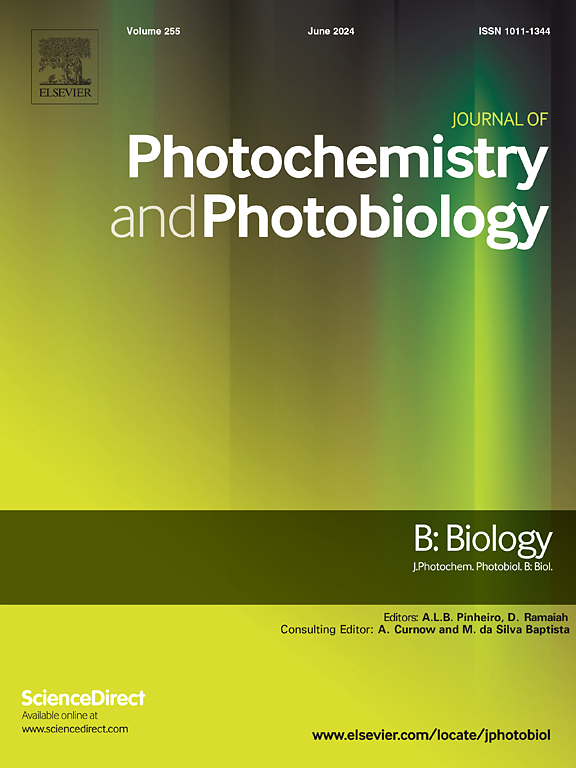Spectral and color temperature dependence of LED exposure on retinal damage and the protective effects of neohesperidin
IF 3.7
2区 生物学
Q2 BIOCHEMISTRY & MOLECULAR BIOLOGY
Journal of photochemistry and photobiology. B, Biology
Pub Date : 2025-03-08
DOI:10.1016/j.jphotobiol.2025.113148
引用次数: 0
Abstract
Purpose
To investigate the effects of LEDs with different spectra and correlated color temperatures on the retina, as well as the protective role of neohesperidin(NHP).
Methods
Sprague-Dawley (SD) rats and 661W cells were divided into four groups: 2700K conventional LED group (CL-2700K), 5000K conventional LED group (CL-5000K), 2700K full-spectrum LED group (FL-2700K) and 5000K full-spectrum LED group (FL-5000K). Retinal damage was detected using Hematoxylin and Eosin (HE) staining, while the expression of mitochondria-related autophagy proteins in retinas was determined through immunofluorescence. The CCK-8 assay, ROS detection, mitochondrial membrane potential assessment and Annexin V-FITC/PI staining were used to assess damage in 661W cell. RT-qPCR and Western blotting were employed to detect the expression of related genes and proteins.
Results
After LED exposure, retinal tissue damage was observed in the rats. 661W cells exhibited upregulated levels of ROS, JC-1 monomer aggregation, and cell apoptosis. Notably, the FL-2700K exhibited the least severe damage. Intervention experiments revealed that 25 μM NHP reduced ROS levels and JC-1 aggregation,as well asmitigated apoptosis levels. Further studies indicated that NHP maintained mitochondrial autophagy at normal levels in 661W cells across all groups and reduced the mRNA expression of Crx and Arrestin-1.
Conclusions
2700K full-spectrum LEDs can mitigate photochemical damage in vivo and in vitro. NHP is a promising drug for treating photochemical damage.
LED暴露对视网膜损伤的光谱和色温依赖性及新橙皮苷的保护作用
目的研究不同光谱和相关色温的led对视网膜的影响,以及新橙皮苷(NHP)的保护作用。方法SD大鼠和661W细胞分为4组:2700K常规LED组(CL-2700K)、5000K常规LED组(CL-5000K)、2700K全光谱LED组(FL-2700K)和5000K全光谱LED组(FL-5000K)。采用苏木精和伊红(HE)染色检测视网膜损伤,免疫荧光法检测视网膜线粒体相关自噬蛋白的表达。采用CCK-8法、ROS检测、线粒体膜电位评估及Annexin V-FITC/PI染色对661W细胞损伤进行评估。RT-qPCR和Western blotting检测相关基因和蛋白的表达情况。结果LED暴露后大鼠视网膜组织出现损伤。661W细胞表现出ROS、JC-1单体聚集和细胞凋亡水平上调。值得注意的是,FL-2700K表现出最轻微的损坏。干预实验显示,25 μM NHP可降低ROS水平和JC-1聚集,减缓细胞凋亡水平。进一步研究表明,NHP使各组661W细胞的线粒体自噬维持在正常水平,并降低Crx和Arrestin-1的mRNA表达。结论2700k全光谱led可减轻体内和体外光化学损伤。NHP是一种很有前途的治疗光化学损伤的药物。
本文章由计算机程序翻译,如有差异,请以英文原文为准。
求助全文
约1分钟内获得全文
求助全文
来源期刊
CiteScore
12.10
自引率
1.90%
发文量
161
审稿时长
37 days
期刊介绍:
The Journal of Photochemistry and Photobiology B: Biology provides a forum for the publication of papers relating to the various aspects of photobiology, as well as a means for communication in this multidisciplinary field.
The scope includes:
- Bioluminescence
- Chronobiology
- DNA repair
- Environmental photobiology
- Nanotechnology in photobiology
- Photocarcinogenesis
- Photochemistry of biomolecules
- Photodynamic therapy
- Photomedicine
- Photomorphogenesis
- Photomovement
- Photoreception
- Photosensitization
- Photosynthesis
- Phototechnology
- Spectroscopy of biological systems
- UV and visible radiation effects and vision.

 求助内容:
求助内容: 应助结果提醒方式:
应助结果提醒方式:


